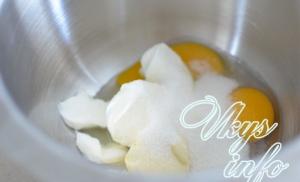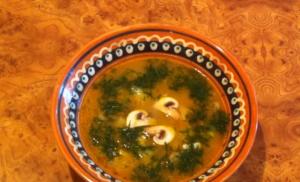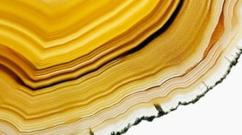Agama Caucasian. Steppe agama (Trapelus sanguinolentus)
The Caucasian agama is a fairly large animal. The length of the body without a tail reaches 15 cm, and the tail is twice as long longer than body.
The Caucasian agama is more massive than the steppe one, its body is strongly flattened. The scales covering the body are heterogeneous: among the small scales there are larger, ribbed and awl-shaped scales. The folds of skin on the neck and sides of the head are covered with enlarged conical scales. The eardrum is located on the surface of the head (and not in a depression, like in the steppe agama). The scales covering the tail are arranged in regular rings, with every two rings forming a well-defined segment.
Above the agama is colored brown or gray tones, depending on the main background of the habitat: on light calcareous rocks it is ash-gray, on basalts it is brown and even almost black, on red sandstones it is reddish-brown.
The ventral side is covered with smooth scales and colored light gray or cream. On the throat there is a dark marble pattern. Young agamas have a clearly visible pattern of alternating dark and light transverse stripes.
Where does the Caucasian agama live?
The Caucasian agama is distributed in the eastern part of the Caucasus, Turkey, Iran, Afghanistan and the south of Central Asia. In Russia, it is found in the mountainous Dagestan.
This lizard is a characteristic inhabitant of the mountains. It lives on rocks, in gorges, on scree, and even on free-standing huge boulders. Various human buildings and ruins are also inhabited by these lizards.
Despite its external clumsiness, the Caucasian agama moves deftly among the stones. Developed claws on powerful paws allow it to hold on to steep slopes, vertical walls, and smooth boulders. This large lizard It can even jump from stone to stone at a distance of up to 40 centimeters. Occasionally it crawls onto trees or bushes. Cracks, crevices and spaces between stones serve as refuges for the Caucasian agama.
In the places of its distribution, the Caucasian agama is numerous and constantly catches the eye. Like the steppe agama, which chooses bushes as observation points, the Caucasian agama is located on towering rocks or on steep slopes and observes what is happening around from there.
Lifestyle
When danger approaches, she rushes to the shelter with lightning speed and, camouflaging herself, presses against the stones located at its entrance. If in this way it is not possible to hide from the enemy, the agama goes into hiding. There it inflates its body, its awl-shaped scales cling to all the surrounding irregularities, and therefore it is very difficult to pull the lizard out of there.
Males of the Caucasian agama, at an observation post, protect their territory from the invasion of other males. At the same time, they periodically squat on their forelimbs (just like male steppe agama). If a stranger violates the boundaries, the owner of the site rushes at him: this attack is enough to put the “invader” to flight. A female (or two, and sometimes even four) constantly lives in the male’s territory. The male is in contact with them all the time, even when the breeding season ends. The courtship behavior of Caucasian dragons exhibits elements unknown in other lizards, for example, the male placing his head on the neck or head of the female. Since all females live within the strictly protected territories of some male, wandering males who do not have such territories do not participate in reproduction (usually these are young individuals).
Like most lizards, adult agamas constantly live in one place, but they often have to migrate. The fact is that for most desert lizards, finding a wintering place in their individual area is not a problem. But in the biotopes of the Caucasian agama the situation is different - rocky slopes freeze deeply in winter and finding a sufficiently deep and reliable shelter here is not easy. Therefore, agamas can migrate from their individual areas to a distance of up to 500 meters. Since there are few places suitable for wintering, each of them can contain several (and sometimes several dozen) agamas - both adults and young. In the spring, agamas make reverse migrations to their permanent habitats.
The same problem faces female Caucasian agama when searching for a place to lay eggs. It is not easy to find it among the rocks, and therefore the females leave their inhabited individual areas and migrate to where there are conditions suitable for the development of eggs ( high humidity, appropriate shelters). Sometimes they have to travel distances of over three kilometers. The young hatched in the egg-laying areas overwinter here and then settle.
The body temperature of lizards in torpor in winter shelters ranges from -0.8 to +9.8°C. During the changeable, warm southern winters, there are periods of steady temperature increases, and then, even in January, Caucasian agamas can appear on the surface - their winter dream not very deep.
What does the Caucasian agama eat?
Like the steppe agama, the diet of the Caucasian agama is very varied. These are mainly invertebrates, which she looks out for from her observation points: beetles, hymenoptera, butterflies, spiders, centipedes. On occasion, the agama will also eat a small lizard (even juveniles of its own species) or a snake. Important role Plant foods play a role in her diet - leaves, fruits, seeds.
Reproduction of Caucasian agamas
The female lays from 4 to 14 large (up to 2.5 centimeters long) eggs in a hole she dug under a stone or in a rock crack. The development of the eggs lasts one and a half to two months, after which small agamas with a body length (without tail) of about four centimeters are born. They grow quickly and reach sexual maturity in the third year of life.
The size of male steppe agama is up to 11.8 cm, females - up to 11 cm. Weight is up to 45 g.
The body is relatively weakly flattened. The head is relatively high, and the scutes on its upper surface are slightly convex. The occipital scute, on which the parietal phases are placed, is no larger than the scutes surrounding it. The intermaxillary shield is small, its width usually only slightly exceeding its height. The nasal shield is not swollen; the nostril is located in its rear part and is almost invisible from above. Upper labial scutes 15-19.
The tympanic membrane in steppe agamas is not located superficially, so that there is a clearly defined external auditory canal. Above the ear there are 2-5 elongated spiny scales. The body is covered with uniform, more or less diamond-shaped scales superimposed on each other. The dorsal scales are large with well-developed ribs, gradually turning into a sharp, more or less triangular spine. The lateral, thoracic and abdominal scales have blunt ribs, and the throat scales are smooth or have underdeveloped ribs. The tail scales are ribbed, arranged in oblique rows and do not form transverse rings.
The main background of the upper body is gray or yellowish-gray. In juveniles, there is 1 row of light gray, more or less oval spots along the ridge, continuing at the base of the tail, and 2 rows of elongated spots of the same color on the sides of the body; Between the spots of two adjacent rows there are larger dark brown or dark gray spots. On the upper side of the legs and on the tail there are blurred dark transverse stripes. With the onset of sexual maturity in males, the dark spots almost disappear, and the light gray ones darken; in females, in general, the juvenile pattern is preserved.
The body color of steppe agamas changes with increasing temperature or as a result of nervous excitement. There are clear differences between the sexes. In males, first the throat, then the sides of the body, belly and limbs become black and blue, cobalt blue spots appear on the back, and the tail becomes bright yellow or orange-yellow. In females, the general background of the body becomes bluish or greenish-yellow, the spots on the back become orange or rusty-orange, and the tail takes on the same color as that of males, but less bright. Agamas from Ciscaucasia are distinguished by their smaller size compared to Central Asian ones (the length of the body with head in males and females is up to 85.8 and 82 mm, respectively) and lower body weight, not exceeding 27.3 g for the former and 23.1 g for the latter.
Some authors believe A. sanguinolenta one of the subspecies of the West Asian species A. agilis Olive However, the differences between specified species are quite constant, and the species independence of each of them leaves no doubt.
Distributed in deserts and semi-deserts of the Eastern Ciscaucasia, Central Asia, and Southern Kazakhstan. Outside the USSR - in Northern and Northeastern Iran, Northern Afghanistan, Northwestern China.
The steppe agama lives in sandy, clayey and rocky deserts and semi-deserts, preferring areas with shrubby or semi-woody vegetation. It is also found on gentle rocky slopes in the foothills, along the edges of weakly consolidated sands, along river banks and in tugai forests, along the outskirts of settlements and along roadsides. In Kopetdag it is known up to an altitude of 1200 m above sea level.
It uses burrows of gerbils, gophers, jerboas, hedgehogs, turtles, voids under stones and cracks in the soil as shelters. During the hot season, agamas often climb onto the branches of bushes, thus protecting themselves from overheating on the hot sun soil. They are able to jump from branch to branch at a distance of up to 80 cm. Sitting on a hill, males survey their area, protecting it from the invasion of competitors.
The number of agamas is usually high: near the village of Pyanj (in South-Western Tajikistan) in March, 123 individuals were counted along a 1 km route; in the western part of the Central Karakum there were from 0.9 to 16.4 individuals per 10 km; in Western Turkmenistan - 1.7; in Southwestern Turkmenistan there were 18 individuals per 1 km; in Karakalpakstan - 4.6 (spring) and 0.8 (summer); in Badkhyz - up to 4 individuals per 1 km.
After wintering, it appears in mid-February, March or early April; males leave winter shelters earlier than females. In the Nogai steppe (in Dagestan) in March-October it feeds on beetles (76.4% of occurrence), hymenoptera, mainly ants (57.3%), butterflies (16.9%), bugs (14.5%), orthoptera ( 5.6%), spiders (4.5%), as well as leaves, flowers and stems of plants (26.8%). In the vicinity of Ashgabat in spring, agamas eat mainly beetles (in different years from 80 to 100% occurrence) and ants (a total of 56%). In Uzbekistan - darkling beetles (from 14.2 to 48.8% of occurrence), lamellar beetles (from 5 to 11%), weevils (from 3.5 to 92.3%), ladybugs(3.8-34.4%), click beetles (4.2-15.3%) and other beetles, hymenoptera, including ants (from 72 to 85%), butterflies and their caterpillars (from 21 to 53% ), homoptera (from 10 to 27%), orthoptera (7-22.2%), bugs (from 15 to 55.5%), termites (4.2-25%), arachnids (4.2-5. 5%), centipedes (up to 3.5%) and, in addition, plant foods(from 3.5 to 42.2).
During the breeding season, males and females of steppe agamas usually live in pairs, but sometimes up to 3 females live in a male’s area. The first laying of eggs in Southern Turkmenistan occurs at the end of April; in South-Western Kyzylkum (Southern Kazakhstan and Tajikistan) - at the end of May - beginning of June; in Karakalpakstan - in the first half of May, and in Dagestan - in early June. The second clutch in Central Asia is in mid-June - early July, and the third, if there is one, in mid-late July. The female lays 4-18 eggs measuring 9-13x18-21 mm in three or four portions per season. Eggs are laid in a hole or in a dug cone-shaped hole.
Young agamas 29-40 mm long (without tail) and weighing 0.95-2.22 g appear from the second half of June to late autumn. In Turkmenistan and Uzbekistan, sexual maturity occurs in the second year of life with a body length of 65 mm in females and 66 mm in males; in Southwestern Kyzylkum, agamas become sexually mature at a length of 80 and 75 mm, respectively; in Ciscaucasia - with a length of about 70 mm.
Practical work No. 1“Study of the adaptability of organisms to their environment”
Goal of the work: consider, using specific examples, the adaptability of organisms to their environment.
Equipment: table showing different types of insect limbs, images of animals from the same genus, sources additional information, determinants or identification cards.
Progress
Consider Various types limbs of insects (running, jumping, swimming, digging). Give examples of insects that have these types of limbs. What do their structures have in common? What's different? Explain the reasons for these differences.
Look at the images of the animals offered to you. Fill the table.
3. Draw a conclusion about the adaptability of specific living organisms to living conditions.
1.
A - running (ant limb)
B- jumping (grasshopper limb)
B- digging (limb of the mole cricket)
G- swimming (limb of a swimming beetle)
The limbs of insects, representing a system of levers movably connected to each other with a large number degrees of freedom, capable of varied and perfect movements.
The limbs are used to move insects. Differences in the structure of the limbs depend on the diverse specialization of insect life, on environment.
For example: the jumping limb has powerful muscles, the running limbs are longer than the digging limbs.
Agama Caucasian
2.
Agama steppe

|
View |
Area |
Habitat |
Body shape and color |
Claw development |
|
Agama Caucasian |
Transcaucasia, Dagestan, Iran, Iraq, Pakistan, Turkmenistan, Tajikistan, Afghanistan. |
Mountains, rocks, rocky slopes, large boulders. |
Color often depends on the background environment. It can be olive-gray, dirty-brown, ash-gray. Length up to 36 cm, weight up to 160 g, body and head flattened, scales heterogeneous. Has a long tail. |
|
|
Agama steppe |
Desert and steppe zones Kazakhstan, Central Asia, Afghanistan, Northern Iran, etc. |
Sandy, clayey, rocky deserts, semi-deserts. They often settle near water. |
The color is light gray, with oval spots. With age, the color changes. Males are brighter than females. Length no more than 30 cm. Scales are uniform, ribbed with spines. Has a long tail. |
Agamas have thin fingers with short hooked claws, the limbs are equipped with five or more fingers, with the fourth finger longer than the third. |
Conclusion: organisms adapt to specific environmental conditions. This can be verified at specific example agam. Means of protecting organisms - camouflage, protective coloration, mimicry, behavioral adaptations and other types of adaptations allow organisms to protect themselves and their offspring.
In Kopet-Dag and in small ridges of the same mountain system Kuren-Dag of the Big and Small Balkhan, as well as in the rocks of the south of Karabil, lives the most numerous and noticeable lizard of these places - Caucasian agama.
The size of its body reaches 160 mm, the tail is slightly longer, its weight is up to 150 g. The head and body are strongly flattened. The scales on the back are varied. A path of five or hexagonal scales, smooth or slightly ribbed, runs along the center of the back. These agamas are olive-brown or olive-gray in color with small black or yellowish spots, and the underside of the body is darkish-gray with a marbled pattern on the throat, in females the belly is pinkish-yellow, in males during the mating period it is blackish-bluish.
This agama is widespread in the Caucasus Mountains, North-Eastern Turkey, Balochistan, Afghanistan and Southern Turkmenistan.
The Caucasian agama is a true mountain lizard, choosing rocks and rocky slopes with sparse vegetation and an abundance of debris for its habitat. rocks. Sometimes it settles in drying sai. Cracks and crevices between stones provide shelter. Agamas run and jump very well. When running across open space, they lift their tail, and when climbing rocks, they press it tightly against the stone, using the prickly tail spines as a support.
Caucasian agamas leave for wintering in November, after wintering they appear at the end of February, in March. In early spring and in the fall, agamas are active in the middle of the day, and in the summer - in the morning and evening hours. IN summer days they come out of their shelters at sunrise. Climbing onto a stone or rock ledge, they spend hours looking for prey. Noticing it, the agama quickly moves towards the prey and unerringly grabs it. In addition to animal food, these lizards willingly eat leaves and seeds of labiates and cruciferous plants.
In late May - early June, females lay eggs. Their average dimensions are 22X13 mm. Newborns appear in August-September. At the age of two years they become sexually mature.
Among the enemies of the Caucasian agama are the multi-colored and red-striped snakes, the Central Asian cobra, the viper, and the black kite. A case of cannibalism has been reported. Lizards moult from March to June.
The Caucasian agama brings certain benefits to mountain pastures, destroying vegetation pests: beetles (weevils, leaf beetles, darkling beetles), ants, bees, wasps, bumblebees, locusts, bedbugs, termites, butterfly caterpillars. Thus, in the mountains of Turkmenistan, among the invertebrate animals eaten by this lizard, 1199 specimens were harmful, 792 specimens were neutral, and only 211 were beneficial.
If you find an error, please highlight a piece of text and click Ctrl+Enter.
Rocky slopes, cliffs, gorges, huge boulders, ruins are the most likely places where you can find such a mountain lizard as the Caucasian agama.
This reptile spreads to the territory of Turkey, Iran, and Dagestan. The reptile is also found in Afghanistan and the eastern part of the Caucasus.
Agama Caucasian: body shape and coloring
The reptile is quite large, the length of the body without a tail is about 15 cm, with a tail - 36 cm. The weight of an adult animal is up to 160 grams. The wide body, base of the tail and angular massive head of the Caucasian agama are flattened, the scales are characterized by different sizes and shapes: on the tail they are located in regular rings. The eardrum is located on the surface of the head. The Caucasian agama, whose claws develop from the base (as in mammals), has thin fingers. The reptile's claws wear down and bend depending on the conditions of existence: the presence or absence of natural shelters, soft or hard ground.
The animal's abdomen is colored cream or light brown. A characteristic feature This species has a dark marbled pattern on the throat. In young specimens, a pattern of transverse stripes is clearly visible: dark and light.

The Caucasian agama is colored brown or gray, which depends on the background of the environment. The reptile living on red sandstones is brown-red, on calcareous rocks it is gray-ashy, the inhabitant of basalt rocks has a brown, almost black color.
Lifestyle
The animal is active until autumn - early winter. With the onset of hibernation, it falls into torpor. Temperature indicator body at this time varies from +0.8 o C to +9.8 o C. At warm winter The body temperature rises, and already in January, waking up from sleep, the animal comes to the surface.

The Caucasian agama is not picky in its diet: it eats plant foods (fruits, seeds, flower buds, leaves), spiders, beetles, and butterflies. Can consume a small snake or a small lizard (even its own species).
Despite its apparent slowness, the Caucasian agama is very agile, moves deftly among stones and is able to jump from one to another at a distance of up to half a meter. Moving along the soil surface, lifts its tail high; climbing the rocks, it presses it against the stones, leaning on its tail spikes. Thanks to its powerful paws and tenacious claws, it is able to hold on to sheer walls, steep slopes, and smooth boulders.

In places of distribution, Caucasian agamas often catch the eye due to their large numbers. In the morning hours (after sunrise), reptiles emerge from their shelters and take long sunbathing, looking out for potential prey along the way. Steep slopes or boulders are used as observation points, on which they can observe what is happening around them. In the process of observing the outside world, they periodically squat on their front legs.
Behavior in case of danger
The Caucasian agama, whose habitat is almost always associated with mountains and foothills, senses the approach of danger at a distance of 20-30 meters. Turning towards the enemy, excitement is revealed by frequent head tilts. Allowing an approaching object to reach 2-3 meters, it rushes to its shelter with lightning speed and, clinging to the stones located at the entrance, camouflages itself. In case of extreme danger, the lizard hides in a shelter, from where it is not possible to extract it: the animal swells in size and clings to all sorts of irregularities with its scales. There are cases of reptiles getting stuck in a narrow gap and their subsequent death from exhaustion.

A caught Caucasian agama, whose habitat extends over many territories, does not resist and falls into a semi-fainting state. At this moment, you can do whatever you want with the reptile: put it on its head, hang it by its tail, put it on its back - the agama will still remain motionless. You can bring the animal out of the state of torpor with a sharp sound (for example, clapping your palm).
Mating period
The observation process and protection of the territory, in which from 1 to 4 females constantly live, are carried out by males. If the boundary is violated by another male representative, the owner of the site immediately attacks him. Such actions are quite enough to put the “invader” to flight.

Mating in Caucasian agamas begins after waking up (March-April) and continues until mid-summer. The male pays attention to all the “ladies” living in his area and communicates with them even after the end of the breeding season. Nomadic males, which are most often young lizards, do not participate in reproduction.
Breeding offspring
The female lays eggs in late spring and summer in a rock crack or a hole dug under a stone. During the season, 2 clutches are possible. The number of eggs (up to 2.5 cm in size) in the nest is from 4 to 14 pieces. After 1.5-2 months from the moment of laying, a new generation of such a unique animal as the Caucasian agama is born. The development of claws and other organs is quite active. Reptiles reach sexual maturity in the 3rd year of life.
Migration of the Caucasian agama
Basically, the Caucasian agama, whose habitat is also recorded in Armenia, Georgia, Turkmenistan and Azerbaijan, lives on permanent place. Sometimes, in search of deep, reliable shelters that help them survive the winter, the animal is forced to migrate. Since places suitable for wintering are often occupied by the same individuals, with the arrival of spring the Caucasian agama returns to its territory. The problem of finding a place also arises for females of this species of lizards, looking for a place to lay eggs. And since it is quite difficult to find it among the rocks, mountain agamas sometimes travel distances of up to several kilometers to find a shelter with suitable conditions. The cubs hatched in the laying areas overwinter there and then spread throughout the territory.
In captivity, the animal should be kept in spacious horizontal terrariums with sufficient height, since the Caucasian agama readily uses vertical surfaces. Gravel is ideal as a soil. Recommended maintenance temperature is +28-30 o C (heated to +40-45 o C). The night indicator should be +18-20 o C. In winter, lizards need to be provided with a cool climate.
The back wall of the terrarium can be shaped like a rock with shallow crevices in which the animal should be able to hide. Various insects can be given as food. It is advisable to diversify your diet a couple of times a week with apples, oranges, and oat sprouts. The Caucasian agama will not refuse newborn mice. For successful maintenance, it is recommended to feed the agama with various mineral and vitamin supplements, as well as irradiate it with ultraviolet light.













